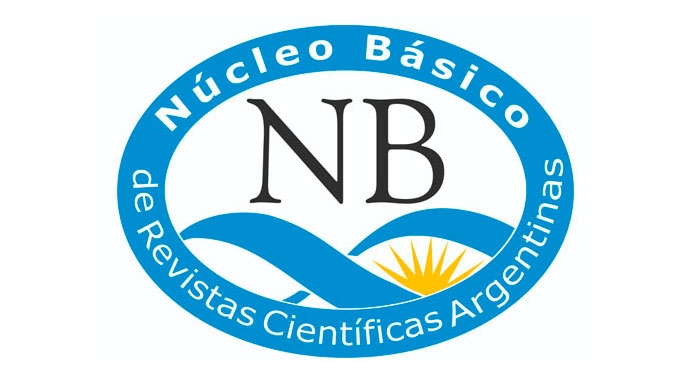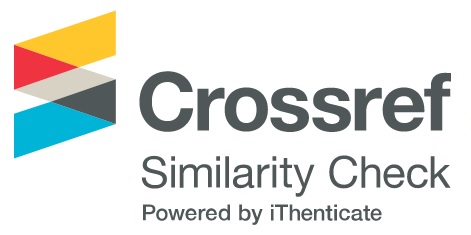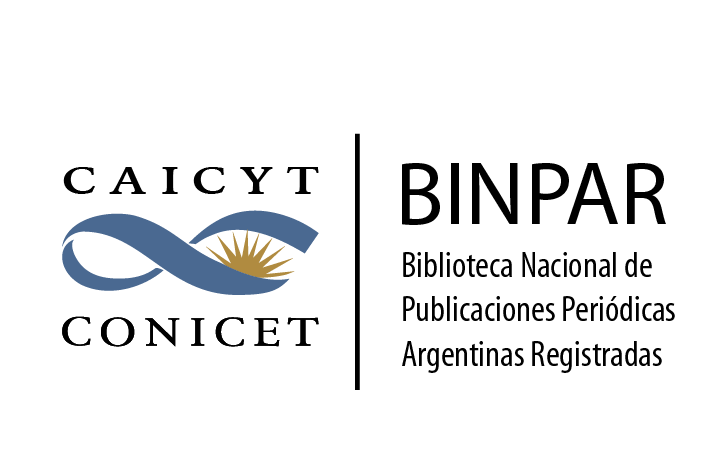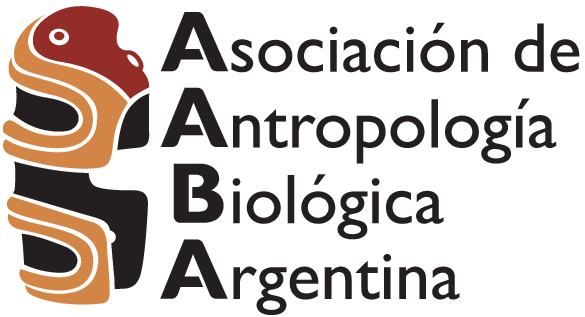Modelos forenses experimentales para la estimación del intervalo postmortem (IPM) sobre restos de Sus scrofa domesticus
Variaciones ambientales en humedales del Conurbano Bonaerense, Provincia de Buenos Aires, Argentina
DOI:
https://doi.org/10.24215/18536387e101Palabras clave:
antropología forense, estimación del intervalo post mortem, modelos experimentalesResumen
La estimación del intervalo post mortem (IPM) puede obtenerse a partir del testimonio de testigos oculares u otro tipo de pruebas ante mortem, como el historial obtenido mediante el uso de dispositivos electrónicos o secuencias de video. Sin embargo, estas fuentes testimoniales, si están disponibles, no suelen cubrir el historial completo de una investigación. En este sentido, los investigadores deberán utilizar diferentes estrategias metodológicas, sean físicas o químicas para estimar el intervalo post mortem. El estudio sistemático a lo largo de un año calendario posibilitó la construcción de secuencias predictivas de descomposición a partir del registro de la temperatura y la humedad en dos ambientes diferentes dentro de sectores de humedales en el Conurbano Bonaerense, lo cual dio como resultado un instrumento metodológico para estimar el IPM en restos biológicos de cerdos (Sus scrofa domesticus) de 35-40 kg. La estimación del intervalo post mortem se basa, en gran medida, en los cambios presentes en el cuerpo. Sin embargo, los factores climáticos y el contexto de depositación de los restos biológicos son factores críticos para tener en cuenta en la cronología de este proceso. Aunque los científicos forenses puedan acceder a una gran cantidad de información técnica/metodológica para estimar el tiempo de muerte, deben tener conocimientos previos sobre el proceso de descomposición a nivel local para ofrecer una estimación del intervalo post mortem que pueda ser útil en una investigación medicolegal.
Descargas
Referencias
Armstrong, P., Nizio, K. D., Perrault, K. A. y Forbes, S. L. (2016). Establishing the volatile profile of pig carcasses as analogues for human decomposition during the early postmortem period. Heliyon, 2(2), e00070. https://doi.org/10.1016/j.heliyon.2016.e00070
Anderson, G. S. y VanLaerhoven, S. L. (1996). Initial studies on insect succession on carrion in Southwestern British Columbia. ASTM Journal of Forensic Sciences, 41(4), 617–625. https://doi.org/10.1520/JFS13964J
American Veterinary Medical Association. (2013). AVMA Guidelines for the Euthanasia of Animals: 2013 Edition.
Bass, W. M. III. (1997). Outdoor decomposition rates in Tennessee. En W. D. Haglund y M. H. Sorg (Eds.), Forensic taphonomy: The postmortem fate of human remains (pp. 181–186). CRC Press.
Bates, L.N. y Wescott, D. J. (2016). Not all degree days are equal in the rate of decomposition: The effect of season of death on the relationship between gross postmortem decomposition and accumulated degree days. En American Academy of Forensic Sciences (Ed.), Proceedings of the 68th Annual Scientific Meeting of the American Academy of Forensic Sciences (p. 178). American Academy of Forensic Sciences.
Bytheway, J. A, Steadman, D. y Wescott, D. (2014). Validation study of the utility of using Total Body Score and Accumulated Degree Days to determine the post-mortem interval of human remains from three human decomposition research facilities (NCJ Report No 255132). U.S. Department of Justice, National Institute of Justice.
Brown, C. y Peckmann, T. (2013). Decomposition rates and taphonomic changes associated with the estimation of time since death in a summer climate: A case study from urban Nova Scotia. Canadian Society of Forensic Science Journal, 46(4), 209–230. https://doi.org/10.1080/00085030.2013.1 0799549
Campobasso, C. P., Di Vella, G. e Introna, F. (2001). Factors affecting decomposition and Diptera colonization. Forensic Science International, 120(1–2), 18–27. https://doi.org/10.1016/S03790738(01)00411-X
Centeno, N. D. y Zalazar, L. (2014). La utilización de un modelo experimental porcino en la investigación de un homicidio. Boletín de la Sociedad Entomológica Argentina, 25(1), 3–5.
Clark, M. A., Worrell, M. B. y Pless, J. E. (1997). Postmortem changes in soft tissues. En W. D. Haglund y M. H. Sorg (Eds.), Forensic taphonomy: The postmortem fate of human remains (pp. 151–170). CRC Press.
Cockle, D. L. y Bell, L. S. (2017). The environmental variables that impact human decomposition in terrestrially exposed contexts within Canada. Science & Justice, 57(2), 107–117. http://doi.org/10.1016/j.scijus.2016.11.001
Cross, P. y Simmons, T. (2010). The influence of penetrative trauma on the rate of decomposition. Journal of Forensic Science, 55(2), 295–301. https://doi.org/10.1111/j.1556-4029.2009.01277.x
Dautartas, A., Kenyhercz, M. W., Vidoli, G, M., Meadows Jantz, L., Mundorff, A. y Steadman, D. W. (2018). Differential decomposition among pig, rabbit, and human remains. Journal of Forensic Sciences, 63(6), 1673–1683. https://doi.org/10.1111/1556-4029.13784
Dirkmaat, D. C., Cabo, L. L., Ousley, S. D. y Symens, S. A. (2008). New Perspectives in forensic anthropology. American Journal of Physical Anthropology, 137(S47), 33–52. https://doi.org/10.1002/ajpa.20948
Duhig, C. (2003). Non-forensic remains: The use of forensic archaeology, anthropology and burial taphonomy. Science & Justice, 43(4), 211–214. https://doi.org/10.1016/S1355-0306(03)71778-X
Galloway, A., Birkby, W. H., Jones, A. M., Henry, T. E. y Parks, B. O. (1989). Decay rates of human remains in an arid environment. ASTM Journal of Forensic Sciences, 34(3), 607–616. https://doi.org/10.1520/JFS12680J
Galloway, A. (1997). The process of decomposition: A model from the Arizona-Sonoran Desert. En W. D. Haglund y M. H. Sorg (Eds.), Forensic taphonomy: The postmortem fate of human remains (pp. 139–150). CRC Press.
Giles, S. B., Harrison, K., Errickson, D. y Márquez-Grant, N. (2020). The effect of seasonality on the application of accumulated degree-days to estimate the early post-mortem interval. Forensic Science International, 315, 110419. https://doi.org/10.1016/j.forsciint.2020.110419
Haglund, W, D. y Sorg, M. H. (Eds.). (1997). Forensic taphonomy: The postmortem fate of human remains. CRC Press.
Hayman, J. y Oxenham, M. (2016). Estimation of the time since death in decomposed bodies found in Australian conditions. Australian Journal of Forensic Sciences, 49(1), 31–44. https://doi.org/10.1080/00450618.2015.1128972
Hewadikaram, K. A. y Goff, M. L. (1991). Effect of carcass size on rate of decomposition and arthropod succession patterns. The American Journal of Forensic Medicine and Pathology, 12(3), 235–240. http://dx.doi.org/10.1097/00000433-199109000-00013
Keough, N., Myburgh, J. y Steyn, M. (2017). Scoring of decomposition: a proposed amendment to the method when using a pig model for human studies. Journal of Forensic Sciences, 62(4), 986–993. https://doi.org/10.1111/1556-4029.13390
Kim, Y. S., Kim, J. H., Yoon, K. S., Kweon, B. S., Kim, Y. S., Lee, G. Y., Cho, H.-W., Kim, H.-R. y Eom, Y.-B. (2018). Feasibility of total body score (TBS) and accumulated degree days (ADD) in the estimation of postmortem interval for forensic murder casework. Biomed Science Letters, 24(1), 35–42. https://doi.org/10.15616/BSL.2018.24.1.35
Lenk, A., Richter, R., Kretz, L. y Wirth, C. (2024). Effects of canopy gaps on microclimate, soil biological activity and their relationship in a European mixed floodplain forest. Science of The Total Environment, 941, 173572. https://doi.org/10.1016/j.scitotenv.2024.173572
Madea, B. (2016). Methods for determining time of death. Forensic Science, Medicine, and Pathology, 12(4), 451–485. https://doi.org/10.1007/s12024-016-9776-y
Marden, K. y Sorg, M. H. (2011). Potential impacts of regional ecologies on the estimation of postmortem interval: case comparisons from Northern New England. En American Academy of Forensic Sciences (Ed.), Proceedings of the 63rd Annual Scientific Meeting of the American Academy of Forensic Sciences (pp. 388–389). American Academy of Forensic Sciences.
Marhoff, S. J., Fahey, P., Forbes, S. L. y Green, H. (2016). Estimating post-mortem interval using accumulated degree-days and a degree of decomposition index in Australia: A validation study. Australian Journal of Forensic Sciences, 48(1), 24–36. https://doi.org/10.1080/00450618.2015.1021378
Mathur, A. y Agrawal, Y. K. (2011). An overview of methods used for estimation of time since death. Australian Journal of Forensic Sciences, 43(4), 275–285. https://doi.org/10.1080/00450618.2011.56 8970
Matuszewski, S. y Mądra-Bielewicz, A. (2016). Validation of temperature methods for the estimation of pre-appearance interval in carrion insects. Forensic Science, Medicine, and Pathology, 12, 50–57. https://doi.org/10.1007/s12024-015-9735-z
Megyesi, M. S., Nawrockie, S. P. y Haskell, N. H. (2005). Using accumulated degree-days to estimate the postmortem interval from decomposed human remains. ASTM Journal of Forensic Sciences, 50(3), 1–9. https://doi.org/10.1520/JFS2004017
Michaud, J.-P. y Moreau, G. (2011). A statistical approach based on accumulated degree-days to predict decomposition-related processes in forensic studies. Journal of Forensic Sciences, 56(1), 229232. https://doi.org/10.1111/j.1556-4029.2010.01559.x
Micozzi, M. S. (1991). Postmortem change in human and animal remains: a systematic approach. Charles C. Thomas Publisher.
Moffatt, C., Simmons, T. y Lynch-Aird, J. (2016). An improved equation for TBS and ADD: Establishing a reliable postmortem interval framework for casework and experimental studies. Journal of Forensic Sciences, 61(S1), S201–S207. https://doi.org/10.1111/1556-4029.12931
Myburgh, J. (2010). Estimating the post-mortem interval using accumulated degree-days in a South African setting [Tesis de maestría, University of Pretoria]. http://repository.up.ac.za/handle/2263/25700
Myburgh, J., Ericka, N. L., Steyn, M. y Becker, P. J. (2013). Estimating the postmortem interval (PMI) using accumulated degree-days (ADD) in a temperate region of South Africa. Forensic Science International, 229(1–3), 165e1–189e6. https://doi.org/10.1016/j.forsciint.2013.03.037
Nasti, A. (2021). Carroñeo y dispersión sobre restos de cerdo doméstico (Sus scrofa) en contextos de humedales: implicancias forenses. Revista Argentina de Antropología Biológica, 23(2), 038. https://doi.org/10.24215/18536387e038
Nasti, A. (2022). Una nueva aproximación a la estimación del intervalo post mortem en restos de Sus scrofa en contextos experimentales ecológicos del conurbano de la provincia de Buenos Aires. Modelos tafonómicos y proyecciones forenses. Revista Internacional de Antropología y Odontología Forense, 5(1), 7–18.
Nasti, A. (2024). Jerarquía, competencia y carroñeo: hacia la construcción de un modelo tafonómico forense para el área periurbana de la Ciudad de Buenos Aires. Revista Internacional de Antropología y Odontología Forense, 7(2), 50–74.
Passalacqua, N. V. y Megyesi, M. S. (2015). A look into the past, present, and future of decomposition research and the estimation of the postmortem interval. En American Academy of Forensic Sciences (Ed.), Proceedings of the 67th Annual Scientific Meeting of the American Academy of Forensic Sciences (pp. 93–94). American Academy of Forensic Sciences.
Payne, J. A. (1965). A summer carrion study of the baby pig Sus scrofa Linnaeus. Ecology, 46(5), 592602. https://doi.org/10.2307/1934999
Pittner, S., Bugelli, V., Weitgasser, K., Zissler, A., Sanit, S., Lutz, L., Monticelli, F., Campobasso, C. P., Steinbacher, P. y Amendt, J. (2020). A field study to evaluate PMI estimation methods for advanced decomposition stages International Journal of Legal Medicine, 134, 1361–1373. https://doi.org/10.1007/s00414-020-02278-0
Rodriguez, W. C. III. (1997). Decomposition of buried and submerged bodies. En W. D. Haglund y M. H. Sorg (Eds.), Forensic Taphonomy: The Post-Mortem Fate of Human Remains (pp. 459–468). CRC Press.
Schiel, M. (2008). Using accumulate degree days for estimating the postmortem interval: a re-evaluation of Megyesi’s regression formulae [Tesis de maestría no publicada]. University of Indianapolis.
Schoenly, K. G., Haskell, N. H., Hall, R. D. y Gbur, J. R. (2007). Comparative performance and complementarity of four sampling methods and arthropod preference tests from human and porcine remains at the Forensic Anthropology Center in Knoxville, Tennessee. Journal of Medical Entomology, 44(5), 881–894. https://doi.org/10.1603/0022-2585(2007)44[881:cpacof]2.0.co;2
Sharanowski, B. J., Walker, E. G. y Anderson, G. S. (2008). Insect succession and decomposition patterns on shaded and sunlit carrion in Saskatchewan in three different seasons. Forensic Science International, 179(2–3), 219–240. https://doi.org/10.1016/j.forsciint.2008.05.019
Shean, B., Messinger, L. y Papworth, M. (1993). Observations of differential decomposition on sun exposed v. shaded pig carrion in coastal Washington State. ASTM Journal of Forensic Sciences, 38(4), 938–949. https://doi.org/10.1520/JFS13492J
Simmons, T., Adlam, R. E. y Moffatt, C. (2010). Debugging decomposition data–comparative taphonomic studies and the influence of insects and carcass size on decomposition rate. Journal of Forensic Sciences, 55(1), 8–13. https://doi.org/10.1111/j.1556-4029.2009.01206.x
Simpson, G. y Strongman, D. B. (2002). Carrion insects on pig carcasses at a rural and an urban site in Nova Scotia. Canadian Society of Forensic Science Journal, 35(3), 123–143. https://doi.org/10.1080/00085030.2002.10757541
Suckling, J. K. (2011). A longitudinal study on the outdoor human decomposition sequence in Central Texas [Tesis de maestría, Texas State University]. https://digital.library.txst.edu/items/fa3c1efce2a9-481c-8230-5e93708a1d1a
Sorg, M. H., David, E. y Rebmann, A. J. (1998). Cadaver dogs, taphonomy, and postmortem interval in the northeast. En K. J. Reichs (Editora), Forensic osteology: Advances in the identification of human remains (pp. 120–144). Charles C. Thomas.
Sorg, M. H. y Marden, K. (2013). Developing frameworks for regional forensic taphonomy research and practice: a multi-regional symposium. En American Academy of Forensic Sciences (Ed.), Proceedings of the 65th Annual Scientific Meeting of the American Academy of Forensic Sciences (pp. 454–455). American Academy of Forensic Sciences.
Steadman, D. W. (2013). Multidisciplinary validation study of nonhuman animal models for forensic decomposition research (NCJ Report No 251553). U.S. Department of Justice, National Institute of Justice.
Sutherland, A., Myburgh, J., Steyn, M. y Becker, P. J. (2013). The effect of body size on the rate of decomposition in a temperate region of South Africa. Forensic Science International, 23(1–3), 257–262. https://doi.org/10.1016/j.forsciint.2013.05.035
Vass, A. A., Bass, W. M., Wolt, J. D., y Foss, J. E. y Ammons, J. T. (1992). Time since death determinations of human cadavers using soil solution. Journal of Forensic Sciences, 37(5), 1236–1253.
Vass, A. A., Barshick, S. A., Sega, G., Caton, J., Skeen, J. T., Love, J. C. y Synstelien, J., A. (2002). Decomposition chemistry of human remains: a new methodology for determining the postmortem interval. ASTM Journal of Forensic Sciences, 47(3), 542–553. https://doi.org/10.1520/JFS15294J
Voss, S. C., Cook, D. F. y Dadour., I. R. (2011). Decomposition and insect succession of clothed and unclothed carcasses in Western Australia. Forensic Science International, 211(1–3), 67–75. https://doi.org/10.1016/j.forsciint.2011.04.018
Wahyono, A. y Alim, D. P. (2022). Estimation of post mortem interval using accumulated degree days (ADD) method. Malaysian Journal of Medicine and Health Sciences, 18(SUPP16), 102–106.
Wescott, D. J. (2018). Recent advances in forensic anthropology: decomposition research. Forensic Sciences Research, 3(4), 278–293. https://doi.org/10.1080/20961790.2018.1488571
Descargas
Publicado
Número
Sección
Licencia
Derechos de autor 2025 Atilio NastiLa RAAB es una revista de acceso abierto tipo diamante. No se aplican cargos para la lectura, el envío de los trabajos ni tampoco para su procesamiento. Asímismo, los autores mantienen el copyright sobre sus trabajos así como también los derechos de publicación sin restricciones.































